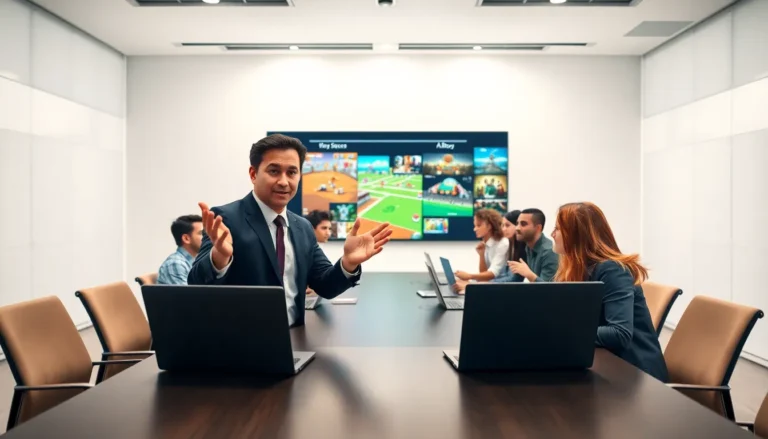In the fast-paced world of gaming, every millisecond counts, and the right monitor can mean the difference between victory and defeat. With so many panel types available, it’s easy to feel like a kid in a candy store—except instead of sugary treats, you’re faced with IPS, TN, and VA panels, each promising to elevate your gaming experience. But which one truly deserves a spot on your desk?
Table of Contents
ToggleOverview of Panel Types
Gamers encounter various panel types, each with unique characteristics. IPS (In-Plane Switching) panels offer vibrant colors and excellent viewing angles. They shine in gaming scenarios requiring accurate color reproduction, making them ideal for visually rich games. Fast response times usually range between 5 to 8 milliseconds, providing smooth visuals with minimal ghosting.
TN (Twisted Nematic) panels focus on speed, catering primarily to competitive gamers. These panels typically have faster response times, often around 1 millisecond. While they excel at reducing motion blur, colors and viewing angles lag behind IPS panels. Competitive gamers seeking minimal input lag often prefer TN monitors.
VA (Vertical Alignment) panels strike a balance between IPS and TN technologies. These panels deliver deeper blacks and better contrast ratios, enhancing the gaming experience in dark environments. Response times for VA panels range from 4 to 6 milliseconds, making them suitable for a variety of gaming genres, although they may not match TN speeds.
Several factors influence the choice of panel type, including game genre and personal preferences. Competitive gamers often prioritize speed and responsiveness, gravitating toward TN panels. Conversely, those who play narrative-driven or visually intense games may favor IPS or VA panels for their superior color performance.
Evaluating these panel types within one’s context proves essential. Selecting the right monitor can significantly impact gameplay, influencing both aesthetics and performance. Gamers should assess their typical gaming environment and gameplay style before making a decision.
IPS Panels
IPS panels, known for their exceptional color accuracy and wide viewing angles, are highly regarded among gamers seeking immersive visuals. Typically, these panels feature response times between 5 to 8 milliseconds.
Advantages of IPS Panels
Vibrant colors define IPS panels, making them ideal for games with rich graphics. Excellent viewing angles enhance the experience, allowing players to see the screen clearly from various positions. Color reproduction stands out, providing true-to-life images that immerse players in detailed environments. Furthermore, many gamers appreciate the consistent brightness levels across the screen, reducing color distortion. IPS technology excels in fast-paced titles, where clarity remains crucial. This combination of features makes IPS panels suitable for visual-heavy genres, such as RPGs and adventure games.
Disadvantages of IPS Panels
Although IPS panels offer numerous benefits, certain drawbacks exist. Higher response times can lead to motion blur in fast-paced games, which can hinder performance for competitive players. Additionally, these panels typically command a premium price compared to TN alternatives, impacting budget considerations. While color depth is impressive, some IPS options can exhibit lower contrast ratios compared to VA panels, affecting depth perception in darker scenes. Many gamers also find that IPS panels are more susceptible to backlight bleed, which can detract from the overall experience. Such factors may lead competitive gamers to explore alternative panel types better suited for speed-centric gameplay.
TN Panels
TN panels, known for their speed, cater to competitive gamers seeking the fastest response times. Their design allows for quick refresh rates, typically around 144Hz or higher, making them ideal for rapid gameplay.
Advantages of TN Panels
Speed represents the primary advantage of TN panels. Response times often reach up to 1 millisecond, providing minimal motion blur and seamless transitions in fast-paced games. Competitive gamers enjoy the improved reaction time, which can enhance performance in competitive environments. Additionally, TN panels tend to be more affordable, appealing to budget-conscious gamers. Brightness levels usually shine higher than in some IPS and VA panels, offering excellent visibility in various lighting conditions. These features collectively draw players who prioritize performance.
Disadvantages of TN Panels
Color accuracy emerges as a key disadvantage. TN panels typically struggle to reproduce vibrant colors compared to IPS or VA counterparts. Viewing angles also present challenges, as colors may shift or wash out when viewed from the side. Limited contrast ratios can affect visual depth, making darker scenes less impressive. Gamers who appreciate immersive visuals may find these drawbacks significant. Overall, while suitable for competitive gaming, TN panels might not satisfy those seeking a rich visual experience.
VA Panels
VA panels provide a solid balance between visual performance and affordability, making them a popular choice among gamers. These panels excel when it comes to achieving deeper blacks and superior contrast ratios, catering to various gaming genres.
Advantages of VA Panels
VA panels offer several advantages for gamers. They produce rich colors that enhance the depth of visuals, especially in darker scenes. Exceptional contrast ratios typically reach up to 4000:1, ensuring that dark and bright areas stand out distinctly. Gamers appreciate their immersive experience when playing narrative-driven or visually stunning games. Additionally, viewing angles are generally better than TN panels, allowing for a more comfortable experience during long gaming sessions. Response times of 4 to 6 milliseconds fit many gaming styles, making these panels versatile and effective.
Disadvantages of VA Panels
Despite their strengths, VA panels come with some drawbacks. Response times, while reasonable, can lag behind TN panels, leading to noticeable motion blur in fast-paced games. They might not deliver the same color accuracy as IPS panels, which can impact visual fidelity in competitively charged environments. Higher prices compared to TN panels may also deter budget-conscious gamers. Backlight bleed can occur, compromising the immersive experience in darker scenes. Balancing these aspects with gaming preferences is crucial when considering VA panels for gaming setups.
Comparison of Panel Types
Choosing the right panel type can greatly affect the gaming experience. IPS panels deliver vibrant colors and wide viewing angles, making them suitable for visually rich games. Gamers favor them for their exceptional color accuracy and clarity in fast-paced genres like RPGs and adventure games. While response times range from 5 to 8 milliseconds, this can contribute to motion blur, which may not appeal to competitive players.
In contrast, TN panels prioritize speed. They typically offer response times around 1 millisecond, significantly reducing motion blur during competitive gameplay. Affordability is another strong point, appealing to budget-conscious gamers. However, limited color accuracy and poor viewing angles often detract from the visual experience, especially for those who enjoy immersive graphics.
VA panels find a middle ground. Rich colors and exceptional contrast ratios, sometimes up to 4000:1, enhance the visual experience, particularly in darker scenes. Gamers appreciate the deeper blacks alongside better viewing angles compared to TN panels. Nevertheless, response times ranging from 4 to 6 milliseconds may not meet the demands of all competitive gamers.
Evaluating these options is essential. Competitive gamers may lean towards TN for its speed. Visual enthusiasts, however, often prefer IPS or VA due to superior color performance. Each type holds unique advantages and disadvantages, making personal preference and gaming style vital criteria when choosing the best panel type for engaging gameplay.
Choosing the right panel type for gaming can significantly enhance the overall experience. Gamers must weigh their priorities between speed, color accuracy, and visual depth. TN panels serve competitive players who need rapid response times while IPS panels cater to those seeking stunning visuals and immersive gameplay. VA panels offer a balanced option for gamers who appreciate rich contrast and colors without sacrificing too much speed.
Ultimately, understanding personal gaming preferences and the types of games played will guide the decision-making process. By selecting the appropriate panel type, gamers can elevate their performance and enjoyment, making every gaming session more engaging and satisfying.


